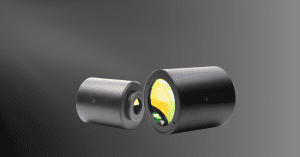Key Takeaways:
- The F-theta scanning lens is vital for laser technology, enabling precise tasks like engraving and cutting.
- Integration with galvanometers ensures accurate correction processes.
- Design nuances, including near-infrared optimization and dual-band variants, cater to diverse laser applications.
Exploring Laser Technology and Design Nuances
Discover the Essence of F-theta Scanning Lens in Laser Technology
The F-theta scanning lens is a vital element in engraving, cutting, and marking systems. Embark on a journey into the core of laser technology with this comprehensive guide. This lens seamlessly integrates with galvanometers and offers precision correction processes. Additionally, it reveals the secrets of the linear image height-to-focal length ratio. The F-theta scanning lens, also referred to as the F-theta field lens, is essential in laser systems. The lens derives its name from its main characteristic – a linear ratio between the optical system image height and focal length expressed as F-theta. This lens is commonly used alongside a galvanometer to adjust laser beam incident direction. This document details the lens’s characteristics, correction methods utilizing software, and the importance of consistent terminology when referring to this lens.
This lens is used for laser engraving, laser cutting, and laser marking systems.
- Characteristics: The F-theta scanning lens has a linear ratio of image height to focal length.
- Correction: To correct the F-theta relationship, software is required and can be achieved through barrel distortion.
- Usage: This lens is often paired with a galvanometer to adjust the incident direction of the laser beam.

Embark on a Wavelength Odyssey with F-theta Scanning Lens
As we explore the specific design nuances of lenses tailored for laser applications. Witness the dominance of near-infrared optimization and the intricate dance of monochromatic design, spanning from UV to CO2. Explore the emergence of dual-band variants that add flexibility to laser systems for various applications.
- Wavelengths Range: F-theta scanning lenses, specifically designed for lasers, cover a broad spectrum of wavelengths from ultraviolet to carbon dioxide.
- Near Infrared Dominance: F-theta lenses are commonly optimized for the near infrared wavelength range, as it effectively meets the high energy requirements of laser engraving and cutting applications.
- Monochromatic Design: The design of F-theta lenses is influenced by the monochromaticity of laser beams. F-theta lenses are usually designed with a narrow bandwidth to match the laser’s particular wavelength. Color correction is frequently excluded from the design process in order to emphasize accurate manipulation of the monochromatic laser beam.
- Dual-Band Variants: Dual-band F-theta lenses are also available on the market, providing an alternative to the standard approach of designing lenses for a specific laser wavelength. These lenses are designed for laser systems that require a visible light pilot light to add flexibility to the application.

In conclusion, our exploration of F-theta scanning lenses has unveiled the intricate synergy between precision engineering and laser technology. From their seamless integration with galvanometers to the correction processes that ensure optical marvels, these lenses stand as indispensable components in laser systems. The linear ratio of image height to focal length, the nuanced design considerations for various wavelengths, and the evolution into dual-band variants showcase the adaptability and sophistication embedded in F-theta lenses. As these lenses continue to play a crucial role in the ever-evolving landscape of laser applications, their unwavering commitment to precision and flexibility solidifies their position at the forefront of cutting-edge technology. The symphony of characteristics, from purposeful design to wavelength wonders, resonates in the lens performance, shaping the future of precision machining and laser applications.
If you’re looking for greater detail, check out the F-theta Scanning Len Part 2.
GREAT ARTICLE!
Share this article to gain insights from your connections!




